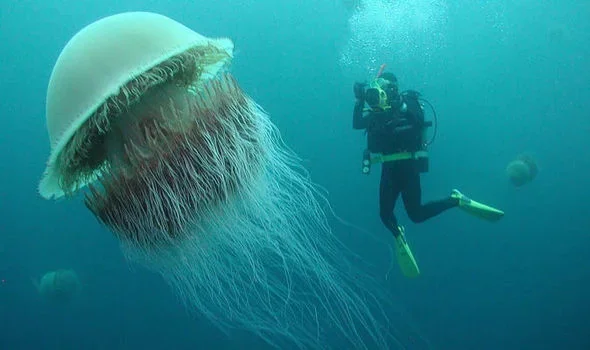Imagine a giant jellyfish with long, wavy tentacles, like a thick lion's mane, slowly drifting in the cold waters of the ocean. Cyanea capillata, known as Medusa-lion's mane - the biggest jellyfish in the world. It lives in the northern seas, where it plays the role of a formidable predator, capturing its prey with long, venomous tentacles.
Thanks to its impressive size and predatory nature Cyanea capillata it has become the object of numerous myths and legends. its giant members can reach more than 2 meters in diameter, and tentacles-an incredible length of up to 36 meters!
In this article, we will look at the scientific classification, structure, habitat, life cycle, nutrition, danger to humans, and the significance of this amazing species for science.

Scientific classification
🔬 Classification of Cyanea capillata:
✔ The Kingdom: Animals (Animalia)
✔ Type: Cnidarians (Cnidaria)
✔ Class: Scyphoid (Scyphozoa)
✔ Row: Discomfort (Semaeostomeae)
✔ Family: Cyaneidae
✔ Gender: Cyanea
✔ View: Cyanea capillata
📌 Interesting!
Cyanea capillata it is one of several species of the genus Cyaneawhich includes other large cold-water jellyfish, such as Cyanea arctica.
Description and appearance
💠 Main Features:
• Dome diameter: from 50 cm to 2.5 meters (record — 2.3 m)
• Color scheme: from pale yellow to maroon
• Tentacles: up to 36 meters (longer than a blue whale!)
• Building: the body is 95% water
• Feature: thick tentacles forming a "mane"
🔹 What makes Cyanea capillata unique?
✔ The biggest jellyfish in the world
✔ The tentacles are dozens of times longer than the body
✔ It is found only in cold seas
✔ There is a known case of poisoning a person with several of his tentacles at once
📌 Interesting!
Record instance Cyanea capillatafound in 1870 off the coast of Massachusetts, the dome was 2.3 meters long and had tentacles 36.5 meters.
Living environment
🌍 Where does Cyanea capillata live?
• North Atlantic (off the coast of Canada, Iceland, Norway)
• Arctic Ocean
• North Pacific (off the coast of Alaska, Russia)
• The Baltic Sea (found in temperate waters)
🌊 Optimal living conditions:
• Water temperature: 0°C – 15°C
• Depth: from the surface to 200 meters
• Salinity: medium or high
📌 Interesting!
Population Cyanea capillata it can change depending on the season – in summer, jellyfish approach the coast, and in winter they go into the depths.

Life cycle
🔄 How does Cyanea capillata reproduce?
1️⃣ Sexual reproduction - males release sperm into the water, which females absorb along with the water currents.
2️⃣ Planula - a tiny larva settles on a hard substrate.
3️⃣ Polyp - the stage of an immobile attached organism that can live for several months or years.
4️⃣ Strobilation - the polyp is divided into many small cells (jellyfish-like larvae).
5️⃣ Yandex. Efira - a young jellyfish that grows into an adult.
📌 Interesting!
Life cycle Cyanea capillata allows it to effectively restore the population even after environmental changes.
Nutrition and environmental role
🍽 What does Cyanea capillata eat?
• Zooplankton (crustaceans, fish larvae)
• Small fish and shrimp
• Other jellyfish
💡 How does she hunt?
Medusa uses venomous cnidocytes on tentacleswhich paralyze the victim.
📌 Interesting!
Medusa-lion's mane is an important link in the marine ecosystemby controlling the population of small fish and crustaceans.

Is it dangerous for humans?
⚠ Toxicity medium or high
• Skin burns, severe burning sensation
• Allergic reactions
• In rare cases-shock or shortness of breath
🚑 What should I do when contacting you?
✔ Clean the wound with sea water
✔ Treat with vinegar or a special antiseptic
✔ Do not rub your skin with fresh water-this will increase the reaction
📌 Interesting!
In 2010, off the coast of New England, one huge Cyanea capillata "burned" more than 100 people when its tentacles broke off and drifted in the water.
Significance for science and people
🔬 Scientific research
* Study it poisons for the development of medical products
• Research bioluminescent properties
* Use in oceanographic research
📌 Interesting!
Many components of jellyfish venom can be used to create painkillers and anti-inflammatory drugs.
Conclusion
Cyanea capillata - this is a real giant of the cold seas, striking for its size and role in nature. It is there the largest jellyfish in the world, a powerful predator and an important part of marine ecosystems.
🌊 Its study opens up new horizons for science, medicine, and understanding of marine ecosystems.